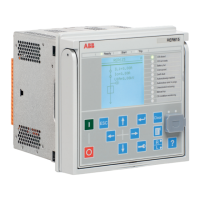The time to lockout release is calculated, that is, the calculation of the cooling time
to a set value. The calculated temperature can be reset to its initial value (the
Initial
temperature
setting) via a control parameter that is located under the clear menu.
This is useful during testing when secondary injected current has given a calculated
false temperature level.
t
lockout release
final lockout release
final n
_
_
ln= − ⋅
−
−
τ
Θ Θ
Θ Θ
(Equation 9)
Here the final temperature is equal to the set or measured ambient temperature.
In some applications, the measured current can involve a number of parallel lines.
This is often used for cable lines where one bay connects several parallel cables.
By setting the
Current multiplier
parameter to the number of parallel lines (cables),
the actual current on one line is used in the protection algorithm. To activate this
option, the ENA_MULT input must be activated.
The ambient temperature can be measured with the RTD measurement. The
measured temperature value is then connected, for example, from the AI_VAL3
output of the X130 (RTD) function to the AMB_TEMP input of T1PTTR.
The
Env temperature Set
setting is used to define the ambient temperature if
the ambient temperature measurement value is not connected to the AMB_TEMP
input. The
Env temperature Set
setting is also used when the ambient temperature
measurement connected to T1PTTR is set to “Not in use” in the X130 (RTD) function.
The temperature calculation is initiated from the value defined with the
Initial
temperature
setting parameter. This is done in case the protection relay is powered
up, the function is turned "Off" and back "On" or reset through the Clear menu.
The temperature is also stored in the nonvolatile memory and restored in case the
protection relay is restarted.
The thermal time constant of the protected circuit is given in seconds with the
Time
constant
setting. Please see cable manufacturers manuals for further details.
T1PTTR thermal model complies with the IEC 60255-149 standard.
4.1.3.5 Application
The lines and cables in the power system are constructed for a certain maximum
load current level. If the current exceeds this level, the losses will be higher than
expected. As a consequence, the temperature of the conductors will increase. If the
temperature of the lines and cables reaches too high values, it can cause a risk of
damages by, for example, the following ways:
• The sag of overhead lines can reach an unacceptable value.
• If the temperature of conductors, for example aluminium conductors, becomes
too high, the material will be destroyed.
• Overheating can damage the insulation on cables which in turn increases the risk
of phase-to-phase or phase-to-earth faults.
1MRS758755 C
Protection functions
REC615 & RER615
Technical Manual
269

